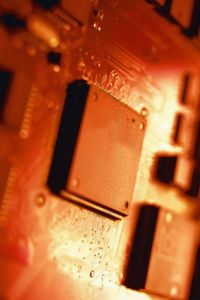Transistors Yesterday And Today
In the 1960s and 1970s, transistorized products mostly used the fundamental junction transistor design developed by Bell Labs. Advances in silicon development in the 1970s led to metal oxide semiconductor field effect transistors (MOSFET). MOSFETs utilize the same principles as other transistors, but the N- and P-types of silicon are less expensive, are arranged differently and are doped with other types of metals and oxides, depending on the intended use.
There are many other transistor types, too. Engineers categorize transistors by their semiconductor material, application, structure, power ratings, operating frequencies and other variables. As technology advanced, engineers learned that they could manufacture many transistors simultaneously, on the same piece of semiconductor material, along with other components like capacitors and resistors.
Advertisement
The result is what's called an integrated circuit. These circuits, usually called just "chips," contain billions of infinitesimal transistors. Since the 1960s, the number of transistors per unit area has been doubling every 1.5 years, meaning engineers can cram more of them into smaller and smaller products.
Modern silicon commercial transistors may be smaller than 45 nanometers in size. They're so small that NVDIA's new graphics card (codenamed GF100) has more than 3 billion transistors, the most ever jammed into one chip. And these transistors are behemoths compared to what's coming in the future.
Scientists from Yale and South Korea recently created the world's first molecular transistor, which is made from a single benzene molecule. Although the tiny size is amazing, engineers stress that they're not concerned so much with bulk as they are efficiency. Contemporary chips create a lot of wasted heat because their transistors don't pass along energy as efficiently as product makers would like; molecular transistors may hold the key to improving efficiency in big ways.
Transistor materials are changing, too, thanks to recent advances in a material called graphene. Graphene transfers electrons much faster than silicon, and could lead to computer processors that are 1,000 times faster than silicon-based products.
No matter where development goes, it's certain that transistors will continue to drive product research and technological advances we can't yet even begin to imagine. Computers will become faster, cheaper and more reliable. Cell phones and music players will shrink to super-tiny dimensions, and still cost less than previous models.
That's the power of transistors in altering the landscape of technology, and ultimately, of our society as a whole. Not a bad run for a simple device invented more than 60 years ago.
Related HowStuffWorks Articles
More Great Links
Sources
- American Physical Society. "This Month in Physics History: Invention of the First Transistor." Physics. (Jan. 26, 2010)http://www.aps.org/publications/apsnews/200011/history.cfm
- BBC News. "Building the Digital Age." (Jan. 26, 2010)http://news.bbc.co.uk/2/hi/technology/7091190.stm
- Bell, Brandon. "NVIDIA's GF100 Graphics Architecture." Firingsquad.com. Jan. 17, 2010. (Jan. 26, 2010)http://news.firingsquad.com/hardware/nvidia_gf100_architecture_overview/
- Bland, Eric. "First Molecular Transistor Created." Discovery News. Jan. 12, 2010. (Jan. 26, 2010)http://news.discovery.com/tech/molecular-transistor-benzene.html
- Choi, Charles Q. "Transistor Flow Control." Scientific American. Oct. 17, 2005. (Jan. 26, 2010)http://www.scientificamerican.com/article.cfm?id=transistor-flow-control
- Computer History Museum. "Field Effect Semiconductor Device Concepts Patented." (Jan. 26, 2010)http://www.computerhistory.org/semiconductor/timeline/1926-field.html
- Computer History Museum. "Invention of the Point-Contact Transistor." (Jan. 26, 2010)http://www.computerhistory.org/semiconductor/timeline/1947-invention.html
- Gray, Theodore. "Making Silicon from Sand." Popsci.com. Oct. 17, 2005. (Jan. 26, 2010)http://www.popsci.com/diy/article/2005-10/making-silicon-sand
- IEEE Global History Network. "The Transistor and Portable Electronics." Sept. 2, 2008. (Jan. 26, 2010)http://www.ieeeghn.org/wiki/index.php/The_Transistor_and_Portable_Electronics
- Nobelprize.org. "The Nobel Prize in Physics 1956." (Jan. 26, 2010)http://nobelprize.org/nobel_prizes/physics/laureates/1956/index.html
- Nobelprize.org. "The Transistor." (Jan. 26, 2010)http://nobelprize.org/educational_games/physics/transistor/function/semiconductor.html
- Nobelprize.org. "The Transistor in a Century Of Electronics." (Jan. 26, 2010)http://nobelprize.org/educational_games/physics/transistor/history/
- PBS. "Silicon P-N Junction." (Jan. 26, 2010)http://www.pbs.org/transistor/science/events/pnjunc.html
- PBS. "Transistor is Invented." (Jan. 26, 2010)http://www.pbs.org/wgbh/aso/databank/entries/dt47tr.html
- PBS. "Transistorized!" (Jan. 26, 2010)http://www.pbs.org/transistor/
- Riordan, Michael. "How Europe Missed the Transistor." IEEE Spectrum. November 2005. (Jan. 26, 2010)http://spectrum.ieee.org/semiconductors/devices/how-europe-missed-the-transistor
- Riordan, Michael. "The Lost History of the Transistor." IEEE Spectrum. May 2004. (Jan. 26, 2010)http://spectrum.ieee.org/biomedical/devices/the-lost-history-of-the-transistor
- Simcoe, Robert J. "The Revolution in Your Pocket." AmericanHeritage.com. Fall 2004. (Jan. 26, 2010)http://www.americanheritage.com/articles/magazine/it/2004/2/2004_2_12.shtml
- Texas Instruments. "Regency Radio Debuts, First Commercial Mass-Produced Transistor Product." (Jan. 26, 2010)http://www.ti.com/corp/docs/company/history/timeline/semicon/1950/docs/54regency.htm
- Texas Instruments Historical Press Release. "First Commercial Radio. TI Supplying Transistors for First 'Pocket-Size' Radio." (Jan. 26, 2010)http://people.msoe.edu/~reyer/regency/TI-1.pdf
- University of Virginia Virtual Lab. "How Semiconductors And Transistors Work." (Jan. 26, 2010)http://virlab.virginia.edu/VL/MOS_kit.htm
- UPI.com. "Single-Molecule Transistor Created." Dec. 28, 2009. (Jan. 26, 2010)http://www.upi.com/Science_News/2009/12/28/Single-molecule-transistor-created/UPI-22521262032655/
